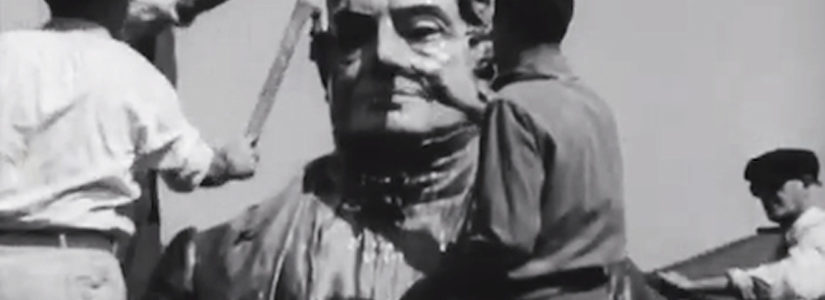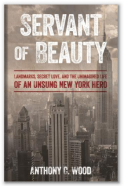
New to Archives: New York City Council Documents, Design Commission Film Reels, & Department of Parks & Recreation Annual Reports!
October 14, 2013
Article from the Fall 2013 Newsletter
Researchers of past preservation struggles involving the New York City Council can now consult a major resource of archival information via the Internet. In May, the La Guardia and Wagner Archives of La Guardia Community College held a ribbon-cutting ceremony for its new Legislative Archive, which includes a vast array of City Council documents from 1955 to 2005. The archive contains 2,500 boxes of correspondence, adopted and proposed legislation, transcripts of meetings at which legislation and landmark designations were discussed, and other miscellaneous background materials. These documents provide the context to council decision making on matters affecting landmarks. Nearly one million of these documents have been digitally scanned and may be viewed on the archive’s website.
An example of the contents within this valuable online archive is the meeting transcripts revealing deliberations on the 2003 City Council decision to disapprove the landmark designation of the Cathedral of St. John the Divine. The Landmarks Preservation Commission (LPC) had made an agreement with the cathedral to designate only a portion of its site at 110th Street and Amsterdam Avenue, excepting two areas where the church wanted to allow a developer to build condominiums. Preservationists challenged the piecemeal designation, and council members voted overwhelmingly to disapprove the landmark designation, overriding a mayoral veto. Transcripts of public hearings and committee meetings on the matter reveal the arguments made by the public and the council’s deliberations behind their decision making. Members of the public argued that the cathedral was meant to stand alone on the site and that a deal allowing condominium development to proceed would be contrary to the historic vision and use of the cathedral site as an open space. Council member Bill Perkins, favoring the disapproval, argued that the deal between the LPC and the cathedral violated the integrity of the landmarking process. Ample testimony was also provided, clarifying the role of local community boards in the fight and revealing the broad-based coalition that had formed to oppose the partial designation deal. The cathedral has still not been officially designated as a New York City landmark.
Another example of the records available online through the Legislative Archive is an extensive paper trail of notes, correspondence, and draft legislation documenting the addition of interior and scenic landmarks to the New York City Landmarks Law in 1973. These documents reveal the support from various quarters around the City for this amendment, and the research and rationale behind their support. A rare dissenting voice was the Real Estate Board of New York, which sent an objection letter. This specific collection also includes marked-up copies of draft legislation, lists of speakers from meetings, and miscellaneous articles related to interior and scenic landmark preservation that had been submitted to the City Council.
The New York City Department of Parks & Recreation has created a digital archive of annual reports and meeting minutes that date back to the mid-19th century, all of which is now available on the agency’s website. The online collection includes annual reports from 1870 through 1930, reports on Central Park dating back to the time of its construction in the 1850s, minutes of parks commissioners’ meetings from 1859 to 1930, and press releases from 1934 to 1970. The annual reports reveal many details of land acquisition, capital investment, park usage, and maintenance activities during these years. Many reports also contain historic photos and historical summaries of individual parks. Department activities outside park boundaries are also documented, such as the planting of street trees. Covering both large parks like Central Park and Prospect Park, and smaller neighborhood parks and playgrounds, the information in this collection is useful to anyone seeking to document the history of parks in the City.
The New York City Design Commission (formerly the Art Commission) is in the process of placing some of its archival collections online. The first to be made available is a series of films prepared by the sculptor Karl Gruppe, who worked for the Parks Department from 1934 to 1937. Gruppe’s films document the poor condition of many monuments, and the repair and restoration activities that took place during the 1930s. Among the monuments carefully documented in the films are the Soldiers’ and Sailors’ Monument at Grand Army Plaza, the Maine Monument at Columbus Circle, and the Carl Schurz Memorial overlooking Morningside Park. The next Design Commission archive to be put online will be the Frank Cousins photography collection. Cousins was hired by the Art Commission in 1913 to document approximately 50 buildings that the commission feared were in danger of demolition. This effort, one of the first examples of official interest in documenting historic architecture, was spurred by the outcry over the loss of St. John’s Chapel, demolished in 1918 when Varick Street was widened.
The Library of Congress has completed digitizing its collection of over 400 panoramic postcards dating from the late-19th and early-20th centuries. The postcards, which were filed with the Library of Congress to establish copyright, show a wide range of parklands, townscapes, historic sites, and buildings from throughout the United States. One of the highlights of this collection is an 1850 panorama of New York City drawn from St. George, Staten Island. In the foreground is the St. George quarantine station, which was destroyed in 1858. The background shows New York harbor from the unspoiled New Jersey palisades to the low, steeple-laden skylines of Manhattan and Brooklyn. Another interesting panorama in the collection is a 1908 postcard showing a baseball game at the former Polo Grounds in Upper Manhattan, revealing not only the old stadium but also a train on the adjacent elevated railroad track (part of the Ninth Avenue El) and the buildings on higher ground overlooking it, including the Morris-Jumel Mansion. Like other collections of historic photos and drawings, this collection is of use to preservationists and historians seeking documentation of historic views.
To view images from the collection, visit the Library of Congress and search for Lot 14058.


